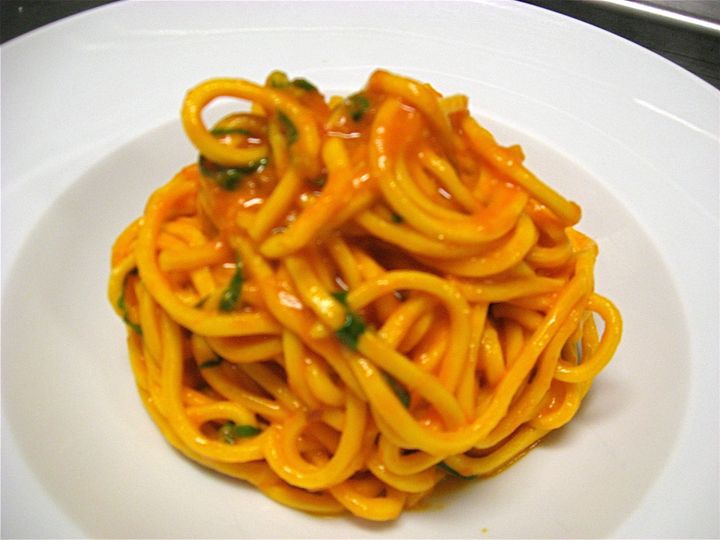
Whether you're a chef like Scott Conant with five restaurants, one wine bar, two cookbooks, countless food show appearances and "a ridiculous amount of ambition," or a novice in the kitchen just looking to make a decent home-cooked meal, Conant's advice is the same -- "Ninety percent is about the product." That's why the pasta he serves at Scarpetta is made fresh daily. The spaghetti robed in his intense, elemental pomodoro sauce gets its yellowish tinge from the yolks of organic eggs.
Working in the kitchen at Scarpetta at the Fontainebleau Miami Beach, Conant ladles a little water from the cooking pasta into the pan of tomatoes cooked down to their very essence. He gives it a swirl and nods. "You see how the sauce goes from red to more of an orange? That's what we're going for," he says. "You don't want it too sharp, too tight, too reduced."
And the fresh pasta and sauce together? A total revelation, the noodles redefining al dente and mated to a sauce that's soulful, rich and rustic, a dish of simple ingredients that's greater than the sum of its parts. Scarpetta sells more pasta pomodoro than anything else on the menu, up to 10,000 plates a month at the New York and Miami Beach Scarpettas alone. So why zone into minutiae like the color and texture of a single dish? Because whether it's happening in the bustling commercial kitchen of Scarpetta or in your kitchen at home, good cooking, says Conant, "is about little things done right."
His attention to detail comes from working dream gigs, like New York's three-star San Domenico, and in dives, like Conant's first restaurant job back in his teens. "Man, that place was disgusting. There was a quarter-inch of grease on everything." The place has long since closed.
Conant grew up in Waterbury, Connecticut, a pudgy Italian-American kid who was great at sports and crazy about food. He began taking cooking classes at the local community college when he was just 11 and graduated from the CIA. Though he claims he wasn't much of a student, Conant, named one of Food and Wine's Best Chefs of 2004, took away lessons from every culinary experience and brought them all to bear at Scarpetta.
Italian for "little shoe," "scarpetta" is also slang for the slipper-shaped piece of bread used to mop up every bit of sauce. "I want everyone to feel comfortable," he says. Even meatless folks, which is why Scarpetta provides a special vegetarian menu. He's seen an uptick in meatless meal requests in all of his restaurants, and rather than being part of the trend, Conant aims to define it with dishes like caramelized fennel with tomatoes, rosemary-braised lentils with broccoli rabe and farfalle with wild mushrooms and escarole. It's food created with thought, not as an afterthought. "It's about changing a mindset," he says. "A plate of steamed zucchini?" Conant makes a face. It is not pretty.
Pretty is one of the reasons Conant, who cooks and eats meat, has become a lot more interested in vegetables. He saw himself on television and thought, "You fat bastard." Since then, "I've really gotten into greens. There's no reason you can't do a great vegetarian meal."
This means you. It does not take a commercial kitchen, a professional staff or even a passion like Conant's. His cookbooks like New Italian Cooking adapt Scarpetta's dishes for home cooks. Even the classic pomodoro, which makes the most of tomatoes now at their seasonal peak.
"It's about simplicity, the inherent elegance of food, attention to product," he says. "Fresh vegetables are a gift from the earth."
Spaghetti with Fresh Tomato Sauce and BasilScott Conant's New Italian Cooking
About 20 ripe plum tomatoes
About 1/3 cup extra virgin olive oil, plus more to finish the dish
Pinch of crushed red pepper
Kosher salt and freshly ground black pepper
1 tablespoon unsalted butter
1 ounce freshly grated Parmigiano-Reggiano (about 1/2 cup)
6 to 8 fresh basil leaves, well washed and dried, stacked and rolled into a cylinder and cut thinly crosswise into a chiffonade
1 pound spaghetti, either high-quality dry or homemadeTo peel the tomatoes: Bring a large pot of water to a boil. Have a large bowl of ice water nearby. Cut a small X on the bottom of each tomato. Ease about five tomatoes in the pot and cook, let boil for about 15 seconds, and then promptly move them to the waiting ice water. (Do this with the remaining tomatoes.) Pull off the skin with the tip of a paring knife. If the skin sticks, try a vegetable peeler using a gentle sawing motion. Cut the tomatoes in half and use your finger to flick out the seeds.
To cook the tomatoes: In a wide pan, heat the 1/3 cup of olive oil over medium-high heat until quite hot. Add the tomatoes, red pepper flakes, and season lightly with the salt and pepper. (I always start with a light hand with the salt and pepper because as the tomatoes reduce, the salt will become concentrated.) Let the tomatoes cook for a few minutes to soften. Then, using a potato masher, chop the tomatoes finely. Cook the tomatoes for 20 to 25 minutes, until the tomatoes are tender and the sauce has thickened. (You can make the sauce, which yields about 3 cups, ahead of time. Refrigerate it for up to 2 days or freeze it for longer storage.)
To serve: Bring a large pot of amply salted water to a boil. Cook the spaghetti until just shy of al dente. Reserve a little of the pasta cooking water. Add the pasta to the sauce and cook over medium-high heat, gently tossing the pasta and the sauce together with a couple of wooden spoons and a lot of exaggerated movement (you can even shake the pan) until the pasta is just tender and the sauce, if any oil had separated from it, now looks cohesive. (If the sauce seems too thick, add a little pasta cooking liquid to adjust it.) Take the pan off of the heat and toss the butter, basil, and cheese with the pasta in the same manner (the pasta should take on an orange hue) and serve immediately.
Serves 4.
